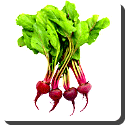 Beet — Beta vulgaris, commonly known as beet or beetroot, is a flowering plant species in the family Chenopodiaceae. Several cultivars are valued around the world as edible root vegetables, fodder (mangel) and sugar-producing sugar beet.
Beet — Beta vulgaris, commonly known as beet or beetroot, is a flowering plant species in the family Chenopodiaceae. Several cultivars are valued around the world as edible root vegetables, fodder (mangel) and sugar-producing sugar beet.
Beta vulgaris is a herbaceous biennial or rarely perennial plant with leafy stems growing to 1-2 m tall. The leaves are heart-shaped, 5-20 cm long on wild plants (often much larger in cultivated plants). The flowers are produced in dense spikes, each flower very small, 3-5 mm diameter, green or tinged reddish, with five petals; they are wind-pollinated. The fruit is a cluster of hard nutlets.
Spinach beet leaves are eaten as a pot herb. Young leaves of the garden beet are sometimes used similarly. The midribs of Swiss chard are eaten boiled while the whole leaf blades are eaten as spinach beet.
In Africa the whole leaf blades are usually prepared with the midribs as one dish.
The leaves and stems of young plants are steamed briefly and eaten as a vegetable; older leaves and stems are stir-fried and have a flavour resembling taro leaves.
The usually deep-red roots of garden beet are eaten boiled either as a cooked vegetable, or cold as a salad after cooking and adding oil and vinegar. A large proportion of the commercial production is processed into boiled and sterilised beets or into pickles. In Eastern Europe beet soup, such as cold borscht, is a popular dish. Yellow-coloured garden beets are grown on a very small scale for home consumption.
Beetroot can be peeled, steamed, and then eaten warm with butter as a delicacy; cooked, pickled, and then eaten cold as a condiment; or peeled, shredded raw, and then eaten as a salad. It is also common in Australia and New Zealand for pickled beetroot to be consumed on a burger.
Garden beet juice is a popular health food. Betanins, obtained from the roots, are used industrially as red food colourants, e.g. to improve the colour of tomato paste, sauces, desserts, jams and jellies, ice cream, sweets and breakfast cereals.
 Kids Portal For Parents India Kids Network
Kids Portal For Parents India Kids Network






